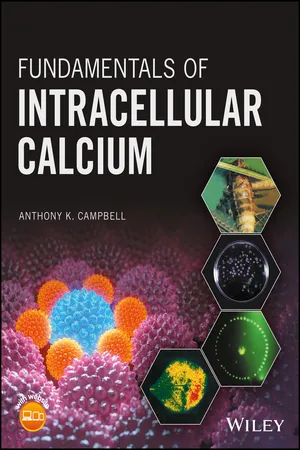
- English
- ePUB (mobile friendly)
- Available on iOS & Android
Fundamentals of Intracellular Calcium
About This Book
The definitive text on the key component for cell functions—intracellular calcium
This comprehensive book reveals the evidence for intracellular calcium as a universal switch in all animal, plant, fungal and microbial cells. It shows how the components required for calcium signaling are named and classified; covers the technology that has been developed to study intracellular calcium; describes how calcium is regulated inside cells and how it works to trigger an event; explains the role of intracellular calcium in disease, cell injury, and cell death; reveals how many drugs work through the calcium signaling system; and demonstrates how intracellular calcium is involved in the action of many natural toxins. The book also illustrates how the intracellular calcium signaling system has evolved over millions of years, showing why it was crucial to the origin of life. Additionally, the book promotes the importance of the molecular variation upon which the intracellular calcium signalling system depends.
Featuring more than 100 figures (including detailed chemical structures as well as pictures of key pioneers in the field), a bibliography of some 1000 references, and a detailed subject index, this definitive work provides a unique source of scholarship for teachers and researchers in the biomedical sciences and beyond.
- Emphasizes two key scientific principles—the first to show how intracellular Ca 2+ acts as a switch, to activate a wide range of cellular events, and the second demonstrating how an analogue mechanism can be superimposed on such a process
- Written by an internationally recognized expert in the field
- Filled with images and references to facilitate learning
Fundamentals of Intracellular Calcium is an all-important text for post-graduate students and researchers working in biomedicine and biochemistry. It is also essential for undergraduate lecturers and their students in physiology, medicine, pharmacy, and the biosciences.
Frequently asked questions
Information
1
Calcium is Special
Ja Kalzium, das ist alles!Otto Loewi (1959)
Learning Objectives
- How everyday events in animals, plants and microbes depend on calcium as a molecular switch inside cells.
- What is special about calcium (Ca2+) that evolution has selected it for this task?
- How calcium was discovered.
- The natural history of Ca2+.
- The requirement of cells for Ca2+.
- How Ca2+ is different from the 28 other elements used in biological processes.
- The four biological roles of Ca2+ – structural, electrical, cofactor and intracellular regulator.
- The molecular biodiversity of the intracellular calcium signalling system, vital in the process of Natural Selection revealed by Charles Darwin and Alfred Russel Wallace.
1.1 Calcium and Everyday Events
- Calcium, always as Ca2+, acts as a switch to instruct a cell to cross a threshold, a Rubicon, and do something. But, it is not the energy source.
- The diversity of molecules that determine when and how a cell fires are a living example of Darwinian variation, upon which Natural Selection depends.
1.2 Discovery of Calcium
Table of contents
- Cover
- Title page
- Copyright
- fprise
- dedication
- About the Author
- Preface
- List of Acronyms
- About the Companion Web Site
- 1 Calcium is Special
- 2 Intracellular Calcium – Principles
- 3 A Century plus of Intracellular Ca2+
- 4 How to Study Intracellular Ca2+ as Cell Regulator
- 5 How Ca2+ is Regulated Inside Cells
- 6 How Ca2+ Works Inside Cells
- 7 How Ca2+ Regulates Animal Cell Physiology
- 8 Intracellular Ca2+, Microbes and Viruses
- 9 Role of Intracellular Ca2+ in Plants and Fungi
- 10 Pathology of Intracellular Ca2+
- 11 Pharmacology of Intracellular Ca2+
- 12 Darwin and 4000 Million Years of Intracellular Ca2+
- 13 They Think It’s All Over
- Index
- Eula